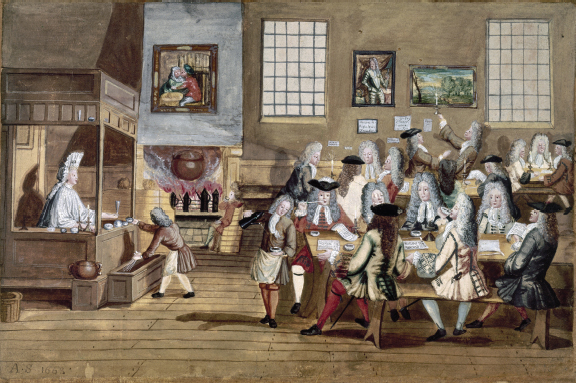Cultural Studies’ Theoretical Perspectives
Developed as an alternative to the predictive theories of social science research (e.g., if X happens, the result will be Y), cultural studies research on media is informed by more general perspectives about how the mass media interact with the world. Two foundational concepts in cultural studies research are (1) the public sphere, and (2) the idea of communication as culture.
The Public Sphere

The idea of the public sphere, defined as a space for critical public debate, was first advanced by German philosopher Jürgen Habermas in 1962.31 Habermas, a professor of philosophy, studied late-seventeenth-century and eighteenth-century England and France, and he found those societies to be increasingly influenced by free trade and the rise of the printing press. At that historical moment, an emerging middle class began to gather to discuss public life in coffeehouses, meeting halls, and pubs and to debate the ideas of novels and other publications in literary salons and clubs. In doing so, this group (which did not yet include women, peasants, the working classes, and other minority groups) began to build a society beyond the control of aristocrats, royalty, and religious elites. The outcome of such critical public debate led to support for the right to assembly, free speech, and a free press.
Habermas’s research is useful to cultural studies researchers when they consider how democratic societies and the mass media operate today. For Habermas, a democratic society should always work to create the most favorable communication situation possible—a public sphere. Basically, without an open communication system, there can be no democratically functioning society. This fundamental notion is the basis for some arguments on why an open, accessible mass media system is essential. However, Habermas warned that the mass media could also be an enemy of democracy, cautioning modern societies to beware of “the manipulative deployment of media power to procure mass loyalty, consumer demand, and ‘compliance’ with systematic imperatives” of those in power.32
Communication as Culture

As Habermas considered the relationship between communication and democracy, media historian James Carey considered the relationship between communication and culture. Carey rejected the “transmission” view of communication—that is, that a message goes simply from sender to receiver. Carey argued that communication is more of a cultural ritual; he famously defined communication as “a symbolic process whereby reality is produced, maintained, repaired, and transformed.”33 Thus communication creates our reality and maintains that reality in the stories we tell ourselves. For example, think about novels, movies, and other stories, representations, and symbols that explicitly or tacitly supported discrimination against African Americans in the United States prior to the Civil Rights movement. When events occur that question reality (like protests and sit-ins in the 1950s and 1960s), communication may repair the culture with adjusted narratives or symbols, or it may completely transform the culture with new dominant symbols. Indeed, analysis of media culture in the 1960s and afterward (including books, movies, TV, and music) suggests a U.S. culture undergoing repair and transformation.
Carey’s ritual view of communication leads cultural studies researchers to consider communication’s symbolic process as culture itself. Everything that defines our culture—our language, food, clothing, architecture, mass media content, and the like—is a form of symbolic communication that signifies shared (but often still contested) beliefs about culture at a point in historical time. From this viewpoint, then, cultural studies is tightly linked with communication studies.